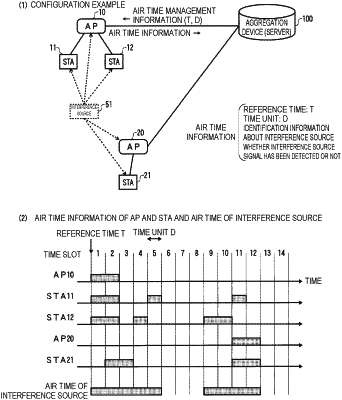| CPC H04W 28/0236 (2013.01) [H04B 17/345 (2015.01); H04W 16/14 (2013.01); H04W 16/18 (2013.01); H04W 28/22 (2013.01)] | 10 Claims |

|
1. A radio communication system comprising:
a plurality of radio devices, wherein:
each radio device among the plurality of radio devices is configured to detect an interference source signal transmitted by an interference source while the radio device is not performing transmission/reception of communications signals;
at least a first radio device and a second radio device among the plurality of radio devices are each configured to generate a respective piece of air time information specifying whether the interference source signal is detected or not detected for each predetermined time unit; and
for at least one predetermined time unit, only one of the first radio device or the second radio device is (i) not performing transmission/reception of communications signals and (ii) generating the respective piece of air time information; and
an aggregation device configured to estimate air time of the interference source by acquiring the respective pieces of air time information from the first and second radio devices and aggregate the acquired respective pieces of air time information by computing a logical sum of the acquired pieces of air time information for each predetermined time unit, wherein a result of the logical sum indicates that the interference source signal is present during the at least one predetermined time unit based on the interference source signal being detected, during the at least one predetermined time unit, by (i) the first radio device but not the second radio device or (ii) the second radio device but not the first radio device.
|